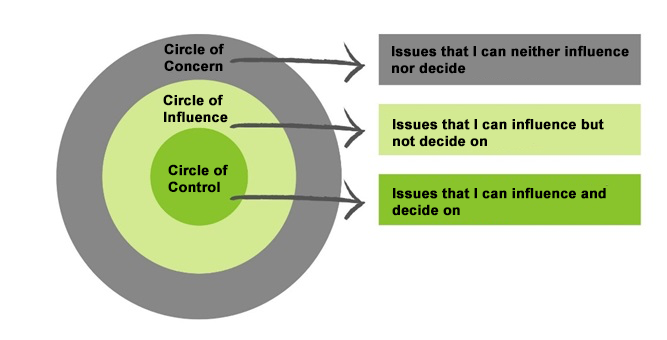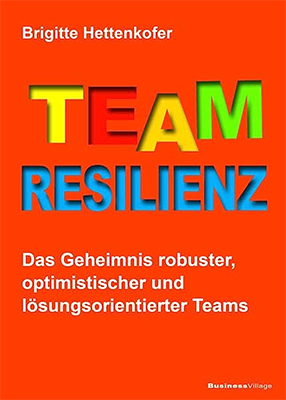Radical acceptance
No more tilting at windmills – Radical acceptance is the way to go
In a difficult situation or even in a crisis, it is crucial to focus our attention on things we can really change or at least influence. Particularly in difficult times, we tend to start a collective lament. In doing so, we overlook the things we can do to at least slightly improve the situation.
To improve our (team) resilience, “radical acceptance” is a powerful tool.
What is radical acceptance?
Radical acceptance is an inner attitude of accepting situations, people or ideas unconditionally. It is about having a deep and comprehensive acceptance for what is. Sounds simple in theory, but how do we get into this attitude?
Resilience research has found that resilient people have a remarkable ability to accept change, setbacks, losses and crises more quickly. They see these challenges as part of life itself and are thus able to maintain their composure even in the face of adversity. Unlike others, they are not easily rattled when things go wrong and recover more quickly from setbacks.
When we succeed in radical acceptance as an inner attitude, we can experience a greater sense of peace, freedom and fulfilment in life.
Basic principles of radical acceptance:
- Radical acceptance is the practice of accepting reality as it really is, free from any resistance or rejection. It involves consciously observing and acknowledging the present moment without judgement or condemnation.
- Radical acceptance asks us to let go of resistance so that we can move forward. It means giving up clinging to the past and recognising that certain things cannot be changed.
- Radical acceptance requires an open attitude towards new experiences and possibilities. It is about being open to different perspectives and flexibly adapting one’s own view.
- Apply radical acceptance to oneself as well. This means accepting oneself with all the strengths and weaknesses and not dragging oneself down through self-criticism.
- Radical acceptance involves developing compassion, both for oneself and for others. It is about being kind and compassionate towards oneself and others, especially in difficult situations.
- Radical acceptance involves accepting unchangeable circumstances without being passive. It is about taking responsibility for what is within one’s control and actively taking action to bring about positive change.
These basic principles serve as guidelines for cultivating a radically accepting attitude. They can be applied effectively not only on an individual level, but also in interpersonal relationships and in a team.
The implementation of radical acceptance in the team
In the context of teamwork, radical acceptance means that every team member can bring their perspectives, skills and opinions to the table and that these are recognised and respected, regardless of differences or views. It is about appreciating and embracing diversity in the team and actively promoting a culture of openness and mutual respect. In this sense, radical acceptance makes for more psychological safety in the team.
It is important to note that radical acceptance does not mean agreeing with everything or that there is no conflict. Rather, it means cultivating an attitude of openness and respect in order to create a conducive environment for effective communication, collaboration and solution finding.
Using the “Circle of Influence” in the team
Stephen R. Covey’s Circle of Influence model¹ provides a valuable framework for assessing our areas of influence and acceptance. It allows us to easily identify what we can change and what we need to accept. This model serves as a practical tool for assessing the current state of affairs.
The idea behind the Circle of Influence is to focus attention and effort on the things that you can actually influence, rather than on those that are outside your sphere of influence. By focusing on the Circle of Influence, a person and a whole team can increase effectiveness, develop self-empowerment and bring about positive change in the professional or social environment.
This model can empower an entire team to regain control over their collective thinking and actions. A team can use this tool to move away from a state of helplessness and dependency. The team collectively directs its attention to the things it can influence and, in the best case, even shape itself. This creates a space for proactive engagement.
When a team is fixated on things beyond its control, this inevitably leads to a downward spiral of frustration and collective whining. This has a negative effect on team spirit and the feeling of being helpless and at the mercy of the situation is reinforced and everyone feels even more at the mercy of the situation.
If a team succeeds in developing radical acceptance, it stops tilting at windmills. New possibilities for shaping and acting open up. Because the team concentrates on what it can do in the present moment. Even if it is only small steps, the team expands its sphere of influence. The expanded sphere of influence strengthens the effectiveness of a team and it experiences more effectiveness again. This ultimately increases the team’s satisfaction and resilience.
Stumbling blocks in developing radical acceptance
One challenge with radical acceptance is that it can be a time-consuming process. It is perfectly normal that we do not immediately succeed in accepting difficult situations. A hasty entry into acceptance mode can easily lead to suppression of the feelings involved. During a crisis, we are often confronted with negative and conflicting emotions, and it is important to acknowledge and be aware of these feelings in a healthy way.
This is why open and honest communication is important. There needs to be a safe space where all concerns and also negative thoughts are allowed to be expressed. These feelings also need to be acknowledged and expressed. However, it is equally important that the team then shifts into a design mode in which the team focuses on finding solutions and moving forward. Even small steps towards solutions should be noticed and appreciated.
In addition, in a team, members often have different levels of acceptance. Some tend to complain and feel hopeless, while others prefer not to complain but to immediately focus on finding solutions and get to work. These individuals are usually the proactive doers in the team, eager to overcome negative feelings and act quickly. Those who need more time often feel blindsided by these team members.
As a general rule, a team in which there is a tendency to complain has more problems coping well in times of crisis. This is because a considerable part of the team’s resources is spent on complaining, leaving little room for developing solutions. From a systemic perspective, the consequences of complaining are not insignificant; they also affect the other team members.
It requires a fine sense of giving space to the worries, stress and emotions before moving into the solution space. At this point, it is often the leader’s job to skilfully manage this process and establish a conscious acceptance management.
The ability to understand and navigate different perspectives in the Circle of Influence and find effective solutions is crucial.
Conclusion
Radical acceptance creates an open and inclusive atmosphere in the team where members can express themselves freely without fear of rejection or negative consequences.
When team members are radically accepted, they feel valued and respected. This creates a positive team dynamic and improves cooperation. Members are more willing to support each other, share ideas and work together to find solutions.
Radical acceptance means that individual differences and diverse perspectives of team members are recognised and valued. This promotes innovation, as different perspectives and experiences can lead to new ideas and approaches.
And radical acceptance facilitates conflict resolution in the team. When conflicts arise, members can communicate openly and honestly with each other without the fear of negative reactions. As a result, misunderstandings can be clarified quickly and conflicts can be resolved effectively.
Notes:
[1] Stephen R. Covey: The 7 Habits of Highly Effective People
Brigitte Hettenkofer has written an interesting book in German: Team Resilienz: Das Geheimnis robuster, optimistischer und lösungsorientierter Teams. Highly recommended!
If you like the article or would like to discuss it, please feel free to share it in your network.
Brigitte Hettenkofer has published another article in the t2informatik Blog:

Brigitte Hettenkofer
Brigitte Hettenkofer (Dipl. Theologin) is passionate about helping people to develop their inner strength and resilience. For twenty years she has been offering consulting, training and team development with her company NeuroResilienz, helping people and teams to remain resilient and psychologically resilient.
Her focus is on inspiring and encouraging teams to navigate strengthened through challenging phases. To realise her vision, she has developed the Team Resilience Wheel, a tool that helps teams recognise and build on their resilience potential: Becoming Stronger Together.


